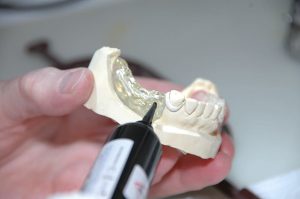Often we can solve dental problems with a simple visit to the dentist, but that’s not always possible. There are cases in which the only solution is removal, which can cause various problems, including aesthetic, psychological, and even physical issues, since missing certain teeth can directly affect your diet and your lifestyle habits. For this reason, a dental prosthesis is often the best alternative. But what exactly is it? In which cases is it recommended? How do you adapt to a dental prosthesis? In today’s article, we’ll cover not only these but many other questions about this topic. So if you’re interested in learning more, read until the end!
What is a Fixed Dental Prosthesis?
First of all, it’s important for us to understand what a dental prosthesis is. We can define this device as something designed to replace a tooth in its absence—in other words, to fulfill all the functions that the original tooth performed. When this technique started to be developed, around the middle of last century, all prostheses were removable, either by fitting or using clasps. Fixed dental prostheses are nothing more than those that cannot be removed. The main advantage is that the person becomes accustomed to them and does not need to worry about cleaning their prosthesis separately from their teeth. In other words, it ends up becoming part of your body too.
When is a Fixed Dental Prosthesis necessary?
Nowadays, using fixed dental prostheses is very common, even though removable ones have not been completely discarded. Basically, there are three situations where a fixed dental prosthesis is necessary:
- To restore chewing function: A fixed dental prosthesis helps the person chew much better than with a removable one. Therefore, when there are problems in this area, it is the most recommended option.
- For speech: Many people have difficulties with diction when using removable prostheses, which can be resolved by using a fixed one.
- For aesthetics: Aesthetically, fixed prostheses are much more advanced. This makes them the option for those who wish to improve the appearance of their smile.
Types of Dental Prosthesis
Now that you’ve learned a bit more about what a fixed dental prosthesis is and when it’s needed, we can finally talk about the existing types. They are:
- Single Crown
- Dental Bridge
- Full Arch Fixed Dental Prosthesis
Let’s talk separately about how each one of them works.
Single Crown
The single crown is used when the tooth is not completely missing—in other words, when some part of it still remains. These “caps” allow it to be complete again, using what remains of the tooth as a base.
Dental Bridge
The dental bridge is necessary when a person’s tooth has fallen out completely. It is supported by the adjacent teeth. This means that for each bridge, at least two other whole teeth are needed.
Full Arch Fixed Dental Prosthesis
The full arch fixed dental prosthesis, as its name suggests, is used when the person has no more teeth in their mouth as a result of diseases such as periodontitis or even weakening of the tissues due to age. It can be placed on either the upper or lower teeth and, nowadays, is usually made with implants.
How to get used to a Fixed Dental Prosthesis?
For a long time, dental prostheses were synonymous with discomfort for those who wore them. Today, with advances in technology, it is much easier to adapt, even if you need some time to adjust. Since it is a part of your body that is not natural, it’s normal to feel a bit strange at first, but this is something that passes with time and allows you to live a completely normal life—and, often, a better one than you had with your previous dental conditions.
How long does a Fixed Dental Prosthesis last?
It’s not possible to pinpoint exactly how long a prosthesis of this type may last, since it depends on various factors, such as the quality of the material used and the care you take with your prosthesis. Therefore, certain habits are essential for it to last longer, such as:
- Brushing the prosthesis along with your teeth or as if you were brushing your teeth
- Avoiding impacts against objects
- Visiting a dentist regularly
- Avoiding cavities in other teeth, as they can infiltrate the prosthesis as well
By following these habits, your prosthesis will certainly last longer, and you’ll also maintain its appearance—which is also very important—for longer. The prosthesis should only be changed when you feel discomfort, have trouble chewing or speaking, or notice that it is already worn. In these cases, it’s important to talk to your dentist about getting a new fixed dental prosthesis. Each person has a different body and a different life history, which means that what is the ideal prosthesis for one person is not always best for another. Of course, with advances in dental studies and technology, nowadays it is easier to know which options are best for solving more serious dental problems. Still, it’s important that you talk to your dentist and understand what your real needs are, whether you need a dental prosthesis or not, and if so, which type. Although the adaptation time can vary, you will get used to it and resume your life as normal. After all, all we want is to live well, peacefully, and without problems that change the way we relate to the world. And a fixed dental prosthesis can help solve that problem. See also: Toothache During Pregnancy: What to Do? How to Relieve?












